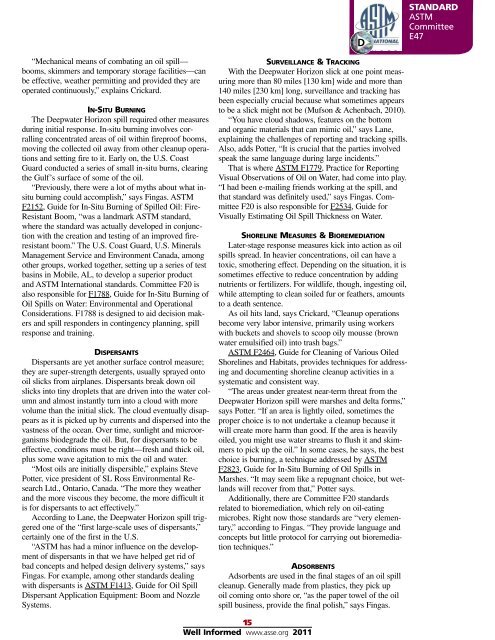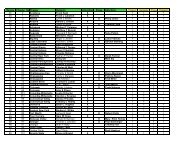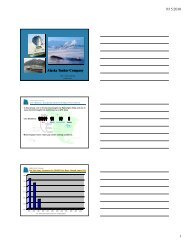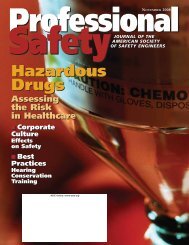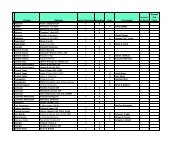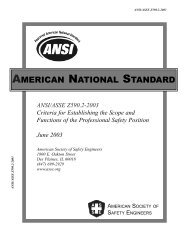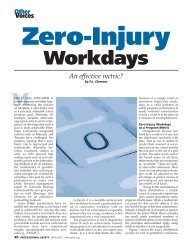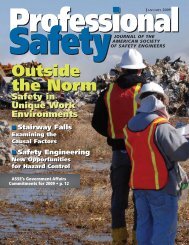OSHA's Flame-Resistant Clothing Policy - ASSE Members
OSHA's Flame-Resistant Clothing Policy - ASSE Members
OSHA's Flame-Resistant Clothing Policy - ASSE Members
You also want an ePaper? Increase the reach of your titles
YUMPU automatically turns print PDFs into web optimized ePapers that Google loves.
DSTANDARDASTMCommitteeE47“Mechanical means of combating an oil spill—booms, skimmers and temporary storage facilities—canbe effective, weather permitting and provided they areoperated continuously,” explains Crickard.IN-SITU BURNINGThe Deepwater Horizon spill required other measuresduring initial response. In-situ burning involves corrallingconcentrated areas of oil within fireproof booms,moving the collected oil away from other cleanup operationsand setting fire to it. Early on, the U.S. CoastGuard conducted a series of small in-situ burns, clearingthe Gulf’s surface of some of the oil.“Previously, there were a lot of myths about what insituburning could accomplish,” says Fingas. ASTMF2152, Guide for In-Situ Burning of Spilled Oil: Fire-<strong>Resistant</strong> Boom, “was a landmark ASTM standard,where the standard was actually developed in conjunctionwith the creation and testing of an improved fireresistantboom.” The U.S. Coast Guard, U.S. MineralsManagement Service and Environment Canada, amongother groups, worked together, setting up a series of testbasins in Mobile, AL, to develop a superior productand ASTM International standards. Committee F20 isalso responsible for F1788, Guide for In-Situ Burning ofOil Spills on Water: Environmental and OperationalConsiderations. F1788 is designed to aid decision makersand spill responders in contingency planning, spillresponse and training.DISPERSANTSDispersants are yet another surface control measure;they are super-strength detergents, usually sprayed ontooil slicks from airplanes. Dispersants break down oilslicks into tiny droplets that are driven into the water columnand almost instantly turn into a cloud with morevolume than the initial slick. The cloud eventually disappearsas it is picked up by currents and dispersed into thevastness of the ocean. Over time, sunlight and microorganismsbiodegrade the oil. But, for dispersants to beeffective, conditions must be right—fresh and thick oil,plus some wave agitation to mix the oil and water.“Most oils are initially dispersible,” explains StevePotter, vice president of SL Ross Environmental ResearchLtd., Ontario, Canada. “The more they weatherand the more viscous they become, the more difficult itis for dispersants to act effectively.”According to Lane, the Deepwater Horizon spill triggeredone of the “first large-scale uses of dispersants,”certainly one of the first in the U.S.“ASTM has had a minor influence on the developmentof dispersants in that we have helped get rid ofbad concepts and helped design delivery systems,” saysFingas. For example, among other standards dealingwith dispersants is ASTM F1413, Guide for Oil SpillDispersant Application Equipment: Boom and NozzleSystems.SURVEILLANCE &TRACKINGWith the Deepwater Horizon slick at one point measuringmore than 80 miles [130 km] wide and more than140 miles [230 km] long, surveillance and tracking hasbeen especially crucial because what sometimes appearsto be a slick might not be (Mufson & Achenbach, 2010).“You have cloud shadows, features on the bottomand organic materials that can mimic oil,” says Lane,explaining the challenges of reporting and tracking spills.Also, adds Potter, “It is crucial that the parties involvedspeak the same language during large incidents.”That is where ASTM F1779, Practice for ReportingVisual Observations of Oil on Water, had come into play.“I had been e-mailing friends working at the spill, andthat standard was definitely used,” says Fingas. CommitteeF20 is also responsible for F2534, Guide forVisually Estimating Oil Spill Thickness on Water.SHORELINE MEASURES &BIOREMEDIATIONLater-stage response measures kick into action as oilspills spread. In heavier concentrations, oil can have atoxic, smothering effect. Depending on the situation, it issometimes effective to reduce concentration by addingnutrients or fertilizers. For wildlife, though, ingesting oil,while attempting to clean soiled fur or feathers, amountsto a death sentence.As oil hits land, says Crickard, “Cleanup operationsbecome very labor intensive, primarily using workerswith buckets and shovels to scoop oily mousse (brownwater emulsified oil) into trash bags.”ASTM F2464, Guide for Cleaning of Various OiledShorelines and Habitats, provides techniques for addressingand documenting shoreline cleanup activities in asystematic and consistent way.“The areas under greatest near-term threat from theDeepwater Horizon spill were marshes and delta forms,”says Potter. “If an area is lightly oiled, sometimes theproper choice is to not undertake a cleanup because itwill create more harm than good. If the area is heavilyoiled, you might use water streams to flush it and skimmersto pick up the oil.” In some cases, he says, the bestchoice is burning, a technique addressed by ASTMF2823, Guide for In-Situ Burning of Oil Spills inMarshes. “It may seem like a repugnant choice, but wetlandswill recover from that,” Potter says.Additionally, there are Committee F20 standardsrelated to bioremediation, which rely on oil-eatingmicrobes. Right now those standards are “very elementary,”according to Fingas. “They provide language andconcepts but little protocol for carrying out bioremediationtechniques.”ADSORBENTSAdsorbents are used in the final stages of an oil spillcleanup. Generally made from plastics, they pick upoil coming onto shore or, “as the paper towel of the oilspill business, provide the final polish,” says Fingas.15Well Informed www.asse.org 2011


